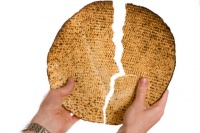Yachatz: Difference between revisions
From Halachipedia
No edit summary |
No edit summary |
||
| Line 1: | Line 1: | ||
[[Image:Yachatz.jpg|200px|right|link=http://tacklingtorah.blogspot.com/2011/04/modern-haggadah-re-telling-passover.html]] | [[Image:Yachatz.jpg|200px|right|link=http://tacklingtorah.blogspot.com/2011/04/modern-haggadah-re-telling-passover.html]] | ||
# One should take the middle of the three matzot and split it in two. One of those at the meal should put away (or hide) the larger piece of [[Matzah]]. <ref> S”A 473:6 </ref> | # One should take the middle of the three matzot and split it in two. One of those at the meal should put away (or hide) the larger piece of [[Matzah]]. We remove it from the table in order to perplex the children to ask the meaning behind this.<ref> S”A 473:6 </ref> The Mishnah Berurah<ref>M"B 473:66</ref> explains that if the children ask why we remove the matzot, the father should answer that we remove it to show that we can’t eat yet because we still have to tell the story of Yetziat Mitzrayim. The Be'er Hetev<ref>Be'er Hetev 473:22</ref> writes that nowadays the common practice is not to remove the Seder Plate because the children know that the food on the Seder Plate is for show and not to be eaten. | ||
# The minhag is to wrap the afikomin in some type of cloth based on the pasuk “משארותם צרורות על שמלותם” <ref>Shemot 12:34</ref> that the Jews carried out the [[matzah]] out of Egypt in sacks on their shoulders.<ref> S”A 473:6, Kitzur S”A 119:4, Nitai Gavriel ([[Pesach]] v. 2, p. 421)</ref> | # The minhag is to wrap the afikomin in some type of cloth based on the pasuk “משארותם צרורות על שמלותם” <ref>Shemot 12:34</ref> that the Jews carried out the [[matzah]] out of Egypt in sacks on their shoulders.<ref> S”A 473:6, Kitzur S”A 119:4, Nitai Gavriel ([[Pesach]] v. 2, p. 421)</ref> | ||
# Some have the minhag to place the afikomin on their shoulder as a remembrance to the jews as they left Egypt.<ref>Kitzur S”A 119:3, Mishna Brurah 473:59</ref> | # Some have the minhag to place the afikomin on their shoulder as a remembrance to the jews as they left Egypt.<ref>Kitzur S”A 119:3, Mishna Brurah 473:59</ref> | ||
# Some have the minhag based on kabbalah to break the [[matzah]] into a daled and vav. <Ref>Ben Ish Chai (Tzav #33), Nitai Gavriel ([[Pesach]] v. 2, p. 421)</ref> | # Some have the minhag based on kabbalah to break the [[matzah]] into a daled and vav. <Ref>Ben Ish Chai (Tzav #33), Nitai Gavriel ([[Pesach]] v. 2, p. 421)</ref> | ||
==Sources== | ==Sources== | ||
<references/> | <references/> | ||
Revision as of 12:57, 23 April 2014
- One should take the middle of the three matzot and split it in two. One of those at the meal should put away (or hide) the larger piece of Matzah. We remove it from the table in order to perplex the children to ask the meaning behind this.[1] The Mishnah Berurah[2] explains that if the children ask why we remove the matzot, the father should answer that we remove it to show that we can’t eat yet because we still have to tell the story of Yetziat Mitzrayim. The Be'er Hetev[3] writes that nowadays the common practice is not to remove the Seder Plate because the children know that the food on the Seder Plate is for show and not to be eaten.
- The minhag is to wrap the afikomin in some type of cloth based on the pasuk “משארותם צרורות על שמלותם” [4] that the Jews carried out the matzah out of Egypt in sacks on their shoulders.[5]
- Some have the minhag to place the afikomin on their shoulder as a remembrance to the jews as they left Egypt.[6]
- Some have the minhag based on kabbalah to break the matzah into a daled and vav. [7]
